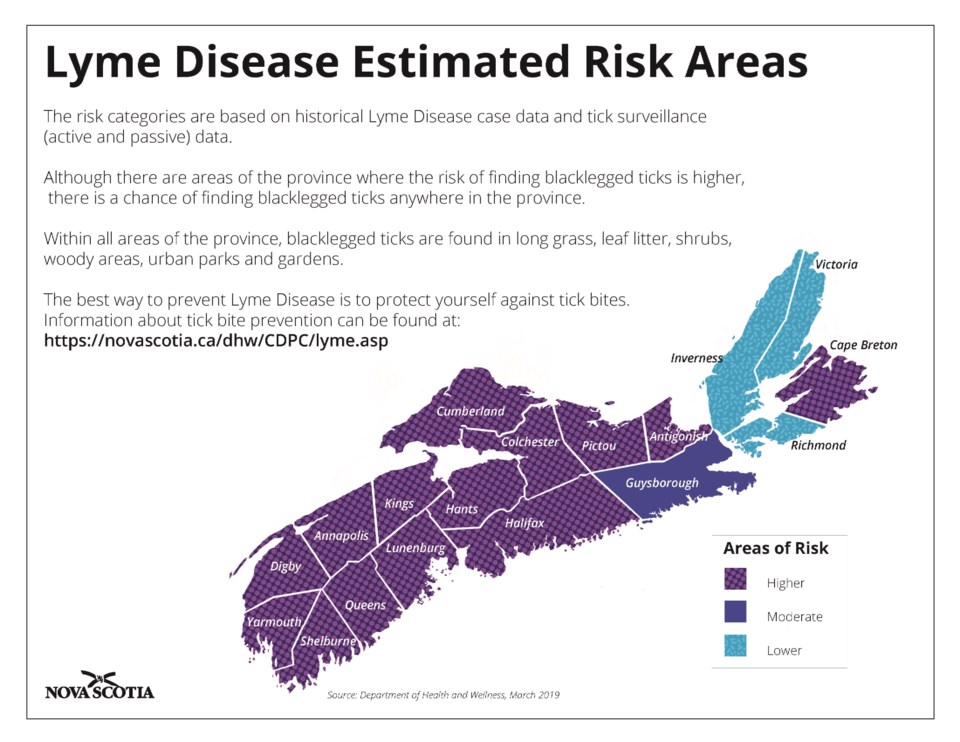Researcher finding more ticks carrying bacteria that causes Lyme disease
Posted Feb 22, 2023 05:44:00 PM.
The threat of Lyme disease appears to be growing in Nova Scotia.
Laura Ferguson of Acadia University's Department of Biology says she's noticed an increase in the number of blacklegged ticks that are carrying the bacteria that causes Lyme disease.
“If we go out and collect our ticks, we find at least half of them carry this bacteria that causes Lyme disease, so that's quite a lot and it's high relative to some other areas as well,” she told CityNews Halifax.
“Now that doesn't necessarily mean you're absolutely going to get Lyme disease, but there's a high risk of it in Nova Scotia.”
According to the province, blacklegged ticks can be found anywhere in Nova Scotia.
As of 2019 — the most recent data provided by the Department of Health and Wellness on its website — all of the mainland, with the exception of Guysborough County, is considered a higher risk area for Lyme disease, along with Cape Breton Regional Municipality.
Guysborough County has a moderate risk and Inverness, Richmond and Victoria counties have a lower risk.

That year, there were 830 confirmed and probable cases of Lyme disease reported in Nova Scotia.
Blacklegged ticks are often found in long grass, leaf litter, shrubs, woody areas, urban parks and gardens.
They're most active in the spring and fall, but you can expect them to be around any time the temperature is consistently 4°C or above, which means there's still a risk in winter.
“There's a lot we don't know about their seasonal movement in and out of the woods or onto trails, we have a lot of questions about that kind of behaviour, but we know they'll wake up in the winter when it's warm enough to permit their bodies to move,” Ferguson explained. “Sometimes they come out and try to find a host.”
There had been some hope a recent cold snap would kill off a bunch of the bloodsuckers. Earlier this month, the thermometer dipped down to about -25 in the Halifax area.
But Ferguson said most of the arachnids likely survived because they hang out in insulated areas.
“I put some temperature loggers out under the leaf litter and under the snow where we'd expect these ticks to be hiding and it didn't go below -6 degrees that night, even though it was -25 in the air, and that's not cold enough to kill them,” she explained.
“Our only hope is that if they get a bunch of ice forming around them in the ground, that can sometimes penetrated into their bodies and kill them at a temperature a little bit higher than we'd normally expect. We can hold onto some hope for that, because the ground was really wet, but … these little things are pretty hardy.”
Ferguson said there are some things you can do to reduce your risk of getting a tick on you, including tucking your pant legs into your socks, wearing long sleeves, and even wrapping duct tape around your ankles sticky side out.
“Repellent like DEET is going to be really useful,” she stated. “There are some natural repellents as well, you have to apply them more frequently.”
When you get home, consider taking a shower and throwing your clothes in the dryer for 20 minutes, then do a tick check.
“There's certain areas they like to get into, any kind of protected folds of skin on your body, in your armpits, in the groin, those kinds of things are a safe spot for them to crawl into,” Ferguson said.
If you do find a tick, there's a good chance it's either a dog tick or a blacklegged tick. Uploading a photo to the eTick app can allow experts to identify which species.
Symptoms for Lyme disease typically appear 3 to 30 days after you have been bitten and may include a rash possibly shaped like a bull's eye, fever, chills, headache, fatigue, aching muscles and joints, and swollen lymph nodes.
Without treatment, more severe symptoms could emerge in weeks to months, including severe headaches, new skin rashes, facial paralysis (such as Bell's palsy), irregular heart beat, joint pain and nervous system disorders.
You can head to a local pharmacy to get assessed for preventive antibiotics at no charge.








